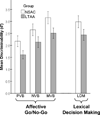Emotion-word processing difficulties in abstinent alcoholics with and without lifetime externalizing disorders
- PMID: 23278634
- PMCID: PMC4545633
- DOI: 10.1111/acer.12026
Emotion-word processing difficulties in abstinent alcoholics with and without lifetime externalizing disorders
Abstract
Background: Evidence suggests that abstinent alcoholics have difficulties processing a variety of emotion-laden stimuli, and some of these difficulties may not fully resolve with long-term abstinence. The current study examined whether emotion-word processing difficulties were present in long-term abstinent alcoholics (LTAA; 18+ months of sobriety) with and without a previously diagnosed externalizing (EXT; antisocial personality disorder and/or attention-deficit/hyperactivity disorder diagnosis) disorder.
Methods: Subjects (N = 121) completed an affective go/no-go (AGNG) task with positive, negative, and neutral emotion-word stimuli, and a lexical decision-making (LDM) task with nonemotion word and nonword stimuli. Nonsubstance abusing controls (NSAC; n = 38, 50.0% women, mean age = 48 ± 7.8), LTAA with EXT (n = 32, 41% women, mean age = 47.1 ± 6.6), and LTAA without EXT (n = 51, 47% women, mean age = 49.7 ± 6.5) were compared between signal discriminability (d') and mean response times (RT) for correct responses (mcRT).
Results: In the LDM task, LTAA had lower (d') values and slower mcRT than NSAC. In the AGNG task, LTAA and NSAC did not differ in AGNG task mcRT. LTAA had lower (d') values than NSAC, and this effect was partially associated with group differences in LDM task (d') values. In LTAA, lower AGNG (d') values also were associated with an earlier age of first drink, greater lifetime alcohol use, and a history of EXT disorder.
Conclusions: Our findings suggest that detecting the emotional content of words is impaired in LTAA, and this impairment is over and above LTAA's more general lexical processing difficulties. Results also suggest that specific emotion processing impairments in LTAA may be exacerbated by greater lifetime alcohol use burden and other comorbid EXT diagnoses.
Copyright © 2012 by the Research Society on Alcoholism.
Figures



Similar articles
-
Psychiatric comorbidity in long-term abstinent alcoholic individuals.Alcohol Clin Exp Res. 2007 May;31(5):795-803. doi: 10.1111/j.1530-0277.2007.00361.x. Epub 2007 Mar 22. Alcohol Clin Exp Res. 2007. PMID: 17378917 Free PMC article.
-
Lifetime and current mood and anxiety disorders in short-term and long-term abstinent alcoholics.Alcohol Clin Exp Res. 2013 Nov;37(11):1930-8. doi: 10.1111/acer.12170. Epub 2013 Jul 29. Alcohol Clin Exp Res. 2013. PMID: 23895247 Free PMC article.
-
Subcortical volumes in long-term abstinent alcoholics: associations with psychiatric comorbidity.Alcohol Clin Exp Res. 2011 Jun;35(6):1067-80. doi: 10.1111/j.1530-0277.2011.01440.x. Epub 2011 Feb 17. Alcohol Clin Exp Res. 2011. PMID: 21332530 Free PMC article.
-
Cognitive deficits in bipolar disorders: Implications for emotion.Clin Psychol Rev. 2018 Feb;59:126-136. doi: 10.1016/j.cpr.2017.11.006. Epub 2017 Nov 21. Clin Psychol Rev. 2018. PMID: 29195773 Free PMC article. Review.
-
Age as a potential modulator of alcohol-related deficits.Alcohol. 2023 Mar;107:12-18. doi: 10.1016/j.alcohol.2022.07.004. Epub 2022 Aug 5. Alcohol. 2023. PMID: 35940507 Review.
Cited by
-
Problematic alcohol use and acute intoxication predict anger-related attentional biases: A test of the alcohol myopia theory.Psychol Addict Behav. 2019 Mar;33(2):139-143. doi: 10.1037/adb0000426. Epub 2018 Nov 19. Psychol Addict Behav. 2019. PMID: 30451511 Free PMC article.
-
The good, the bad, and the ambivalent: Extrapolating affective values for 38,000+ Chinese words via a computational model.Behav Res Methods. 2024 Sep;56(6):5386-5405. doi: 10.3758/s13428-023-02274-3. Epub 2023 Nov 15. Behav Res Methods. 2024. PMID: 37968560
References
-
- American Psychiatric Association. DSM-IV-TR: Diagnostic and Statistical Manual of Mental Disorders. Washington, DC: American Psychiatric Publishing; 2000.
-
- Bauer D, Cox WM. Alcohol-related words are distracting to both alcohol abusers and non-abusers in Stroop colour-naming task. Addiction. 1998;93:1539–1542. - PubMed
-
- Bartsch AJ, Homola G, Biller A, Smith SM, Heinz-Gerd W, Wies AL, et al. Manifestations of early brain recovery associated with abstinence from alcoholism. Brain. 2007;130:36–47. - PubMed
Publication types
MeSH terms
Grants and funding
LinkOut - more resources
Full Text Sources
Medical

